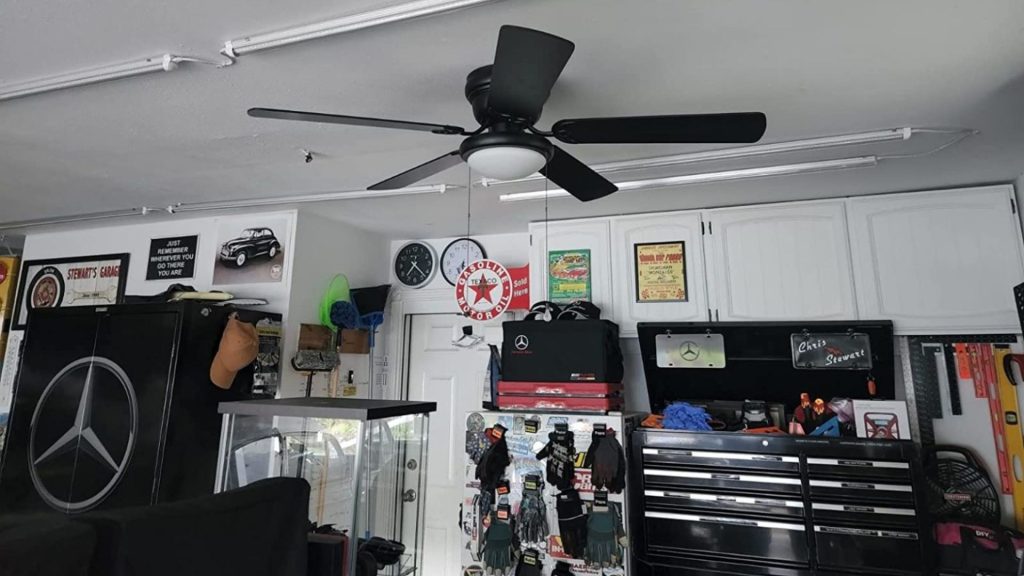
Did you realize that Garage ceiling fans are a relatively new innovation in the world of ceiling fans? They are made specifically to be set up in a garage, where they will both chill and ventilate the space. Therefore, there are certain things you should know before buying a garage ceiling fan.
There are two primary varieties of Garage ceiling fans, including the regular and the low profile. While regular fans are more prevalent, low-profile models are more space-efficient and better suited for tight quarters like a garage. To keep you cool as you work in the garage, most models incorporate motion sensors that activate the fans as you arrive and deactivate them once you leave. If you ever forget to turn the fan off, this is a great safety net.
Also Read: Most Expensive Ceiling Fans
When working late in the garage, a light fixture coupled to a ceiling fan might be a welcome addition. Anyway, stay reading because we’re about to tell you how to select the greatest garage ceiling fan. Let’s not waste any more time and get to the point.
If you are in a hurry, my top 3 picks for the greatest garage ceiling fans are shown here.
Top 8 Best Garage Ceiling Fans
1. Hunter 53294 Builder Elite 52 Inch Ceiling Fan
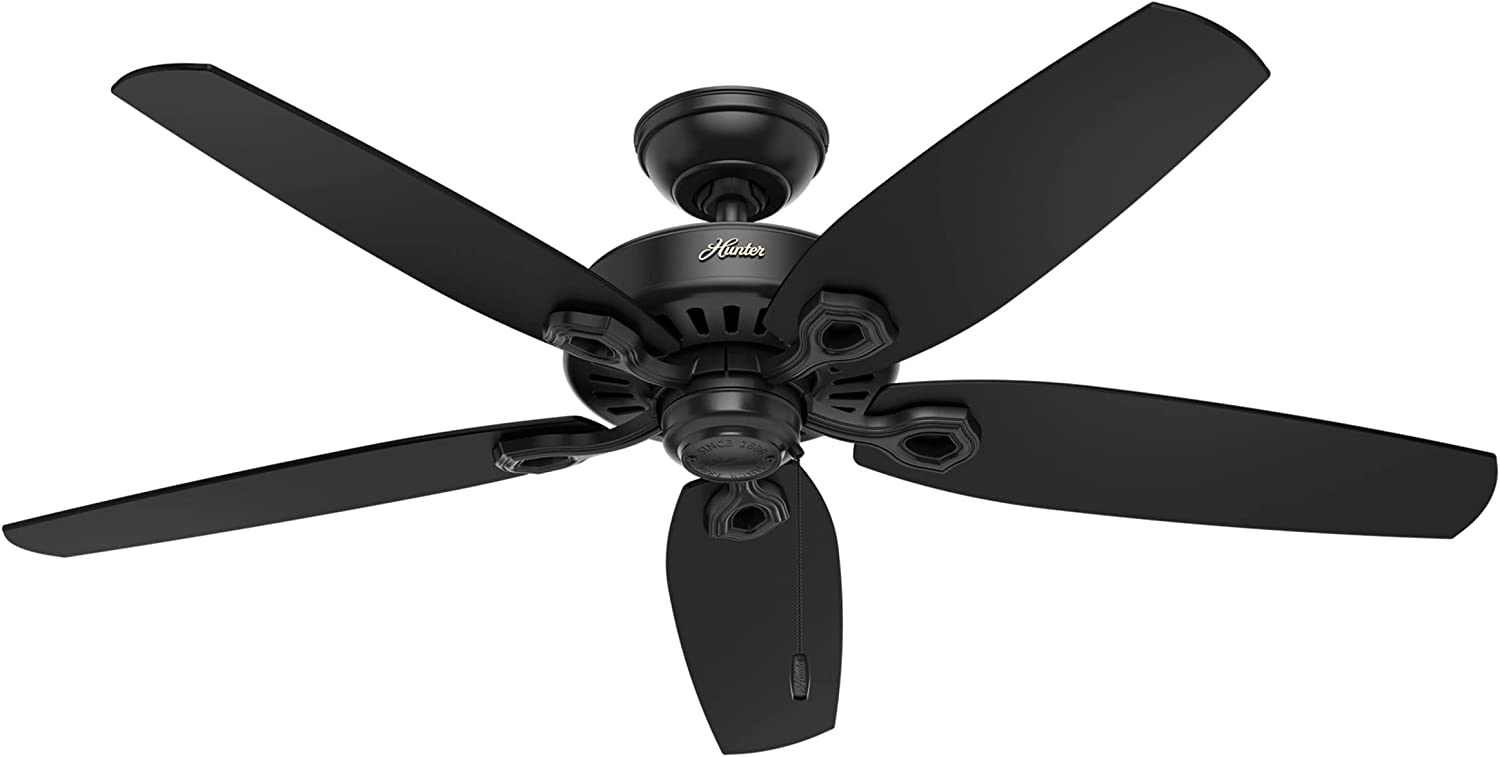
Top Features
- Blade Span: 52 Inches
- Airflow Capacity: 4999 CFM
- Air Flow Efficiency: 94 CFM/W
- Pull-Chain Control
- Damp Rated
The Builder Elite Fan from Hunter Ceiling Fan Company is the finest option for a garage with a floor space of up to 225 square feet.
This fan has 5 blades, and the photo clearly shows that their pitch is 13 degrees. It has a maximum airflow of 4999 CFM and essentially runs at varying speeds. If we look at the average airflow produced by this fan, however, we find that it is 3565 CFM (Cubic Feet per Minute). The finest part about this fan is its 94 CFM airflow efficiency, which translates to 94 cubic feet per minute every watt of power consumed.
This ceiling fan has a pull chain and is suitable for use in moist environments. The fact that it is resistant to the moisture in the air is, in all honesty, one of the nicest qualities of this garage ceiling fan. The fact that it has a high resistance to moisture makes it an excellent option for basements and garages.
Also Read: Best Ceiling Fans Without Lights
However, even the smallest garages are usually at least 10 feet by 20 feet, and our Hunter fan, with its 52-inch blade spread, is only an entry-level model.
The diameters of the two downrods that come with this fan are 2 and 3 inches. These extra inches help the ventilation reach its fullest potential by allowing the air to be spread evenly around the garage.
Pros
- The ceiling fan is Damp rated for outdoor use
- Perfect for one vehicle garage
- Quiet Operation
- Aesthetic Looks
Cons
- No Remote Controller Choice
2. Big Ass Fans i6 60 Inch Commercial Ceiling Fan
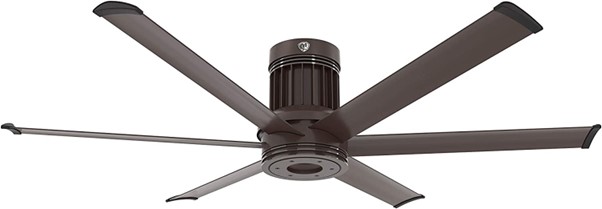
Top Features
- Blade Span: 60 Inches
- Airflow Capacity: 9676 CFM
- Air Flow Efficiency: 248 CFM/W
- Remote Control, Voice, and App Control
- Damp Rated for use in outdoor space
You may probably guess by the size of this ceiling fan given its name. You should choose this fan if your garage is more than 400 square feet. In addition, it includes a plethora of extras that no other fan on this list can provide.
A quick peek at the i6 Ceiling fan’s blades reveals a design that’s reminiscent of helicopter blades. Blades with a span of 60 inches are comparable, though. Plus, at full throttle, this fan can move 9676 cubic feet of air per minute (CFM).
This ceiling fan operates at a slower pace than the previously stated fans, but it moves a much larger volume of air. This, I believe, is what allows for a steady airflow across the whole garage.
In addition to its attractive design, this ceiling fan is equipped with an EC Motor, which offers much higher performance than a DC Motor. That’s why the Energy Star programme approved this ceiling fan, which features variable speeds and a 248CFM/W airflow efficiency. When it comes to adjusting the i6 Fan’s speed, you have many options, including a bluetooth remote control feature and the ability to use a smartphone app.
Additionally, the SenseMe technology found in the original remote control for the fan is a nice bonus. This gadget can measure the room’s temperature and humidity and regulate the fan’s velocity accordingly.
In addition, voice-activated assistants such as Google Home and Alexa may operate this fan. Despite being flush placed, this ceiling fan nevertheless provides exceptional air movement.
Pros
- This fan is Energy Star Appraised
- Higher Proficiency
- Different Control Choices
- Calm Activity
- Can be controlled by means of Application
Cons
- Not found
3. Monte Carlo Maverick Super Max Energy Star Outdoor Ceiling Fan
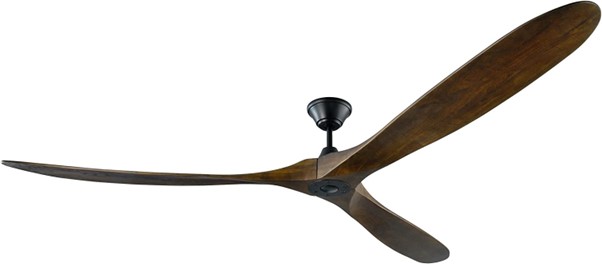
Top Features
- Blade Span: 88 Inches
- Airflow Capacity: 14784 CFM
- Air Flow Efficiency: 380 CFM/W
- Six-speed remote control
- Damp Rated
The 88-inch blade span of the Monte Carlo Maverick makes it a top pick for an outdoor ceiling fan. Do you really think that? A massive 88-inch blade span, which is sufficient to cool off an area greater than 900 square feet.
This ceiling fan has a 52-inch blade span, but it also comes in 60-, 70-, and 99-inch variants. As is common knowledge, the airflow ratings are determined by the blade spans.
The maximum airflow is 14784 CFM. Three blades are used to guarantee optimal airflow. Blade material is Balsa wood. These fans may be used in wet areas since they are made from a unique type of wood that is resistant to water.
Also Read: Best Barnwood Rustic Ceiling Fans
The ceiling fan’s air flow efficiency is the greatest on the market at 380 CFM/W. We already know what a ceiling fan’s reverse function does in the winter, and this one has that, along with six forward speeds and a remote control system.
This ceiling fan comes with a downrod that is 6 inches long and extends the fan’s reach to 13 inches, making it simple to install.
Pros
- Moist evaluated with wooden cutting edges
- High effectiveness in Energy Use
- High wind stream
- Controller with 6-speeds
- Various sizes accessible
- A tranquil fan
Cons
- No Remote Controller Choice
4. Hunter 59262 Cassius 3 Blade 3 Speed Ceiling Fan
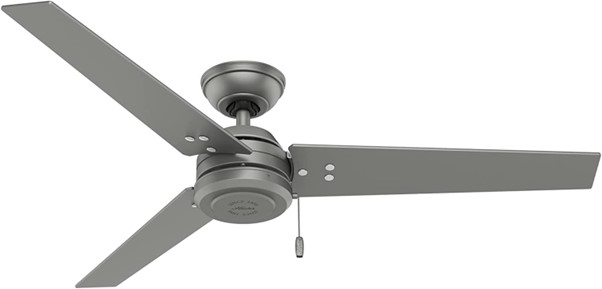
Top Features
- Blade Span: 52 Inches
- Airflow Capacity: 5537 CFM
- Air Flow Efficiency: 98 CFM/W
- Pull-Chain Control
- Damp Rated
Do you have a modest-sized garage? If so, the Hunter 59262 Cassius Ceiling Fan won’t disappoint. This fan is ideal for a 225 square foot garage.
This Hunter ceiling fan is perfect for you if you value classic design. This fan has the classic appearance of a three-blade Ceiling Fan, as we have already said. In addition, a pull chain is included for operating the ceiling fan and switching it on and off.
Additionally, this fan has somewhat better air flow efficiency than the Builder Elite Fan. After a successful installation, you’ll be blown away by the incredible breeze in your garage thanks to the ceiling fan and its two downrods (three inches and five inches long). Plus, it helps you save money on your utility bills because it is energy efficient.
So, if your garage is at least 9 feet high, then it’s a good idea to go for it. Review the product’s benefits and drawbacks, nevertheless, before committing to a purchase.
Pros
- Damp Rated Ceiling Fan
- Good for single car garages
- Energy Efficient Fan
Cons
- No Remote Control
- Traditional Design
5. Casa Vieja Domain Modern Rustic Large Ceiling Fan

Top Features
- Blade Span: 72 Inches
- Airflow Capacity: 7699 CFM
- Air Flow Efficiency: 254 CFM/W
- Six Speed Remote Control
- Wet Rated For Outdoor
This gorgeous ceiling fan is worth considering if you’re on the hunt for a modern fan with lights. The greatest part is that none of the other ceiling fans on the list come with a light kit, making this one unique. The light kit can be concealed if you’re not a fan of them, but it’s a huge hit any way.
With a diameter of 72 inches, this is one of the largest ceiling fans on the market. The five blades are composed of ABS and feature an oak veneer. With a blade pitch of 14 degrees, the effectiveness of the airflow is maximized.
Now let’s talk about the fan’s remote control features. This model has six different speeds that can be adjusted wirelessly. The air flow may be switched around, too.
Also Read: Best Ceiling Fans With Bright Lights
In other words, if your garage is no more than 625 square feet, this fan is perfect for you. With a maximum airflow of 7699 CFM and an air flow efficiency of 254 CFM/W, this fan meets the criteria for Energy Star certification. You’re probably wondering why it is that this particular fan is more productive. DC motors, like the one used in this fan, are more energy-efficient than AC motors, the kind often seen in ceiling fans.
This is the only fan on our list that has a wet rating; all the others are damp. That a fan has been “wet rated” indicates that it can tolerate being submerged in water. A water hose may also be used to clean the blades of a ceiling fan. The downrod that comes with this ceiling fan is six inches in length.
Pros
- Energy-efficient
- It is suitable for two or three-car garages.
- 6-speed remote control
- Water-resistant and wet-rated.
- Includes an LED kit for lighting
- Quiet and smooth running
Cons
- Not found
6. Casa Vieja Predator Rustic Industrial Ceiling Fan
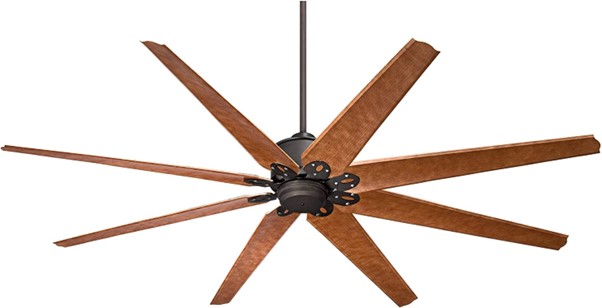
Top Features
- Blade Span: 72 Inches
- Airflow Capacity: 6775 CFM
- Air Flow Efficiency: 229 CFM/W
- 6 Speed Remote Control
- Damp Rated
Have you have a big garage at home? If so, this Predator Ceiling Fan is perfect for you! It appears like a real predator thanks to its eight long blades. In addition, the airflow efficiency of these blades is 229 CFM/W, and they can produce a maximum airflow of 6775 CFM.
The downrod on the 72-inch-wide Casa Vieja Predator ceiling fan is four inches long. The ABS blades have a lovely appearance and a pitch of 14 degrees.
The ceiling fan’s DC motor allows it to achieve an impressive 229 CFM/W in terms of airflow efficiency. It shares the same Energy Star rating as the previous ceiling fans.
Along with the other ceiling fans we’ve looked at, this one also has a remote control with six different speeds. In the colder months, you may use the reverse function on the remote to have the ceiling fan run in the opposite way.
After being mounted, a ceiling fan hangs down a comfortable 12.25 inches from the ceiling. Thus, when this installation process is complete, your garage will have enough of room for optimal air circulation. To sum up, if the ceiling height of your garage is 9 feet or more, this is the ceiling fan for you.
Pros
- Energy Star rated fan
- 6-speed remote control
- UL damp rated
- Whisper quiet performance
Cons
- No light kit included
7. Turbina XL Modern Contemporary Industrial Large Ceiling Fan
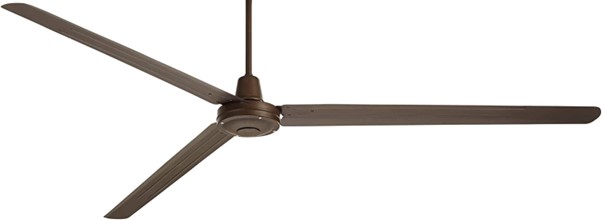
Top Features
- Blade Span: 84 Inches
- Airflow Capacity: 10594 CFM
- Air Flow Efficiency: 110 CFM/W
- 6-speed hand-held remote control
- Damp Rated
Another model of ceiling fan designed for extremely large garages is the Turbina XL. Three long blades with a 15-degree pitch make up its classic shape. It has metal blades with a diameter of 84 inches.
The MonteCarlo fan indicated above is somewhat larger, although the size difference is negligible in practise. The rapidity of its airflow is immediately apparent. The fan’s airflow is 10594 CFM, which is less than the MonteCarlo fan. Also, while decent, this fan’s 110 CFM/W rating is significantly lower than that of the other.
This ceiling fan has six speeds, all of which are adjustable with the included remote. Although it has a damp rating and may be used in garages, the manufacturer advises against putting it in places with high humidity.
The fan includes a downrod that is 6 inches in length. The manufacturer recommends that this fan not be put lower than 10 feet from the ground.
Pros
- Oil-rubbed bronze finish motor
- Remote control with reverse function
- UL listed for damp locations
Cons
- No light kit included
8. Westinghouse Lighting 7861400 Industrial 56-Inch Ceiling Fan
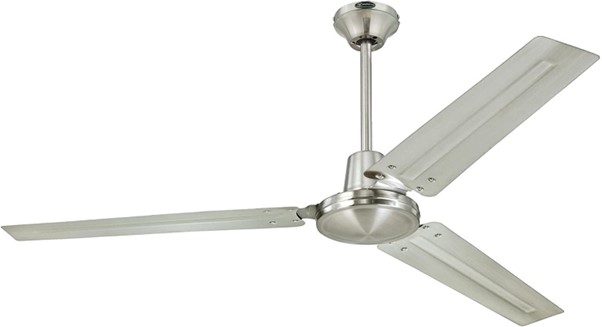
Top Features
- Blade Span: 56 Inches
- Maximum Airflow: 5973 CFM
- Area Cover: 400 sq. ft.
- 5-speed fan control
If you’re looking for a ceiling fan for your garage, look no further than the Westinghouse Lighting 7861400. It’s hard to find anything that can match the mix of sleek design and powerful functionality that this product provides.
Given that it is meant to be mounted on the ceiling of a garage rather than the floor or a wall, installing it will inevitably be more complicated than the installation of a standard garage fan. Nonetheless, the Westinghouse’s straightforward instructions make it easier to set up than comparable ceiling fans.
As one of the most powerful fans on the market, this silent garage fan can provide airflow of up to 5370 CFM. When set at its highest speed, the Westinghouse garage ceiling fan can generate a wind that is competitive with that of the most powerful fans in our best ceiling fans list.
The fan’s speed is controlled via a wall-mounted box with a manual twist dial. This box is larger than we’d want, but it has five speed settings and reverse for the fan blades, which is really useful.
The brushed nickel and stainless steel construction of this wall mount fan not only enhances its functionality, but also gives it a stylish, modern industrial appearance.
Pros
- Elegant and enticing layout
- Strong, yet quiet performance
- More adaptable bidirectional fan blade
Cons
- No light kit
How to Choose the Right Garage Fan
Important Factors to Think About
Effectiveness and Power
The temperature in a garage may rise rapidly. Since this is the case, it’s important that the garage fan you end up buying is both dependable and effective. The efficiency of a garage fan, like that of any other fan, is measured in CFM, or cubic feet of air moved per minute. Selecting a garage fan with a CFM rating of one or more per square foot of garage space is often recommended. It’s not a terrible idea to acquire something with a little more power, though, because garages normally require more electricity to cool down.
Lifespan and steadiness
It’s unreasonable to be concerned about knocking something over when working in the garage. That’s why it’s crucial to choose a fan for your garage that won’t break down anytime soon. Look for metal construction while shopping for frames or supports. High-quality mounting hardware is something you should seek out if you need to install fans. The versatility of mounted fans is remarkable, but many of the available alternatives are not as sturdy as they should be. A garage fan should be able to withstand being bumped around without being damaged. High durability can be indicated by the use of metal for things like frames and fan grills.
Also Read: Best Bladeless Ceiling Fans
Speed and Adaptability
Garage fans are great for when you require a strong gust of air moving in a single direction, but there are occasions when you might want to change the speed or the direction of the airflow. Therefore, it is suggested that you look for a solution that allows for varying speeds. You should also look for a garage fan that has reversible airflow. When it comes to fans, the ones with adjustable fan heads are the most convenient.
Volume of Noise
Your fan is no different from any other, in that you should think about the level of noise it makes. However, garage music listeners are less likely to care about this. This is because, by definition, a garage is a loud environment where acoustics aren’t a top priority. However, you shouldn’t get something that’s too loud, especially if you plan on spending a lot of time in the garage.
Instructions for Picking the Appropriate Garage Fan Size
You need to know the square footage of your garage before you start shopping for a ceiling fan. Be sure to watch these tutorials on YouTube for in-depth guidance on how to accurately measure a room’s square footage in meters.
Also Read: Best Enclosed Ceiling Fans
It’s important to know the square footage of your garage before you shop for a ceiling fan, but this shouldn’t be too difficult as most garages adhere to conventional dimensions. Some rough estimates are provided for your perusal below.
- 12-by-22-foot (264 ft2) garage is adequate for a single automobile.
- Dual-car garage measuring 18 by 20 feet (360 square feet)
After calculating the square footage of the garage in meters, the following step is to select a ceiling fan whose dimensions are suitable for the space.
- Ceiling fan, 44″-50″ in diameter, for rooms of 114-2,220 square feet
- 225–400 square feet, 50” or bigger ceiling fan
- A 62″ or bigger ceiling fan is required for any room that is 400 square feet or greater.
Typically, ceiling fans with a 60″ blade range are a decent choice for garages of a medium size. There is a wide variety of ceiling fans in this size, since it is a popular choice.
Also Read: Best Hampton Bay Ceiling Fans
Frequently Asked Questions
Q1. To what factors should I pay attention while picking out the ideal garage ceiling fan for my needs?
Both the garage’s size and the local temperature should be taken into account when deciding on a ceiling fan for the space. A large, powerful fan that can move a lot of air is essential if you have a large garage or live somewhere warm and humid. A smaller fan may be preferable if your garage is very small or if you live in an especially chilly environment.
Q2. What is the best way to mount a ceiling fan in my garage?
A ceiling fan for a garage may be easily installed. Finding the exact centre of your garage and installing a ceiling mount there is the first step. Then, at the midpoint, use a drill to make a hole in the ceiling. Screw the mounting bracket into place once it has been positioned in the hole. Next, attach the fan to the mounting bracket and turn it on.
Q3. To what extent can installing a ceiling fan in your garage improve its comfort levels?
Incorporating a ceiling fan into a garage has several advantages. It may assist maintain the garage at a comfortable temperature and aid with air circulation. Pollen and dust may be filtered out of the air as well. Thirdly, it aids in lowering utility costs because the garage is kept cooler in the summer and warmer in the winter.
Also Read: Flush Mount vs Downrod Ceiling Fan
Q4. Do you worry about utilising a ceiling fan in a garage?
Putting up a ceiling fan in a garage has no serious risks and should be done. Nonetheless, you must guarantee that it is securely fastened and unimpeded in any way. It’s also a good idea to keep the kids and dogs away from the workspace.
Q5. Is it okay to run the ceiling fan in the garage during the winter?
The garage ceiling fan may be used year-round, even when temperatures drop. You must keep in mind that the fan’s air-moving abilities will be diminished if the garage doors are closed. Additionally, you may think about setting up a space heater with a fan to maintain a comfortable temperature in the garage.
Q6. The summertime heat has me wondering if I may use the ceiling fan in my garage.
In fact, you can put that ceiling fan to good use this summer. Keep in mind that the fan’s air-moving abilities will be diminished if your garage door is open. In addition to the fan, you could also put in a window air conditioner to ensure that your garage is comfortably cool.
Also Read: Difference Between Indoor and Outdoor Ceiling Fan
Q7. Can I use my garage ceiling fan all through the year?
The garage ceiling fan may be used all year round. However, keep in mind that the fan’s ability to move cold air would be diminished if the garage doors are closed. Electric windows or a space heater with a fan are two more options for year-round garage cooling.
Q8. How long can I expect the life of my garage ceiling fan to be?
Garages can benefit from an ordinary ceiling fan for many years. It’s important to keep in mind that the lifespan of a garage ceiling fan might differ depending on the product’s manufacturer and how often it’s used. Cleaning and maintaining your ceiling fan is very important if you want it to last as long as possible.
Q9. Can I hang a light from the ceiling fan in my garage?
It is possible to put the light fixture in the garage’s above. However, keep in mind that the illumination might not be as intense as that provided by a standard light bulb. It’s also possible that the garage won’t be adequately illuminated by the light
Also Read: Do Ceiling Fans Reduce Radon
Q10. Do I need to get a certain kind of ceiling fan for my garage?
You may choose any garage ceiling fan you choose that works for your needs. However, it’s still important to be aware that there are several models of garage ceiling fans to choose from. In addition, before buying a fan, you should examine its features and specs.
Q11. Is There a Minimum Size for a Garage Ceiling Fan?
The length of your vehicle and the width of your garage determine the answer to this inquiry. In any case, 50- to 60-inch garage ceiling fans are what you want to stay with if you have a typical-sized garage. These proportions should provide for sufficient ventilation without causing uncomfortable gusts. Garages larger than 400 square feet might benefit from a ceiling fan with a width of roughly 60 inches.
Q12. When it comes to a ceiling fan, how many blades is ideal?
It makes no difference if you need a ceiling fan for your bedroom or your garage. Either way, the number of fan blades must be consistent.
Generally speaking, the number of blades necessary to effectively circulate air is three. Some devices can function with as little as four blades, while others require as many as five, however these have more involved installation procedures. Furthermore, they often make more noise, weigh more, and use more energy.
Many distinct variations of ceiling fans are available for use in a garage. It’s important to keep in mind that garage ceilings aren’t standard issue. In addition, before purchasing a fan, it is crucial to examine its features and specs. If you put in the time and effort to learn about and compare your options, you’ll find the perfect garage ceiling fan for your needs.
Also Read: How much does it cost to run a ceiling fan
Conclusion
In addition, ceiling fans may be used securely in garages, albeit there are certain safety considerations to keep in mind. It is essential, however, that your fan is properly installed and not hindered in any way. When the fans are on, it’s also crucial to keep dogs and kids away from them. If you adhere to the recommendations and safety precautions outlined in this article, you should have no problems using the ceiling fan in your garage.
About The Author
